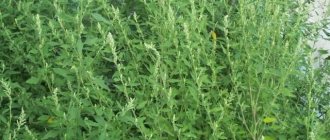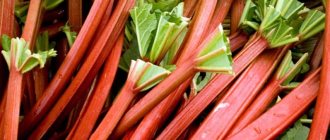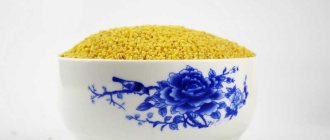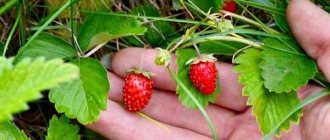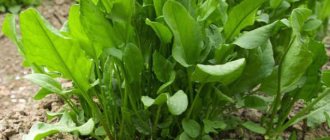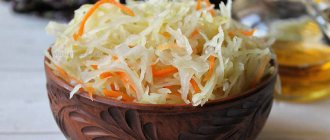Botanical description
Ramson is a perennial herbaceous plant belonging to the Amaryllis family. This plant gets its name from the Latin Allium ursinum. Wild garlic is listed in the Red Books of the Russian Federation, Ukraine, Latvia, Lithuania, Belarus.
In our country, wild garlic is known among local residents as bear onion, kalba, wild garlic, and flask. In Germany, this herb is commonly called green bear onion. This is explained by the fact that clubfooted predators love to feast on this plant when they wake up from hibernation. Ramson helps restore the body by saturating it with vitamins. Interestingly, before flowering begins, it looks very similar to lily of the valley. It can be distinguished only by its characteristic smell. It grows mainly in the Siberian region.
The grass has a slightly elongated basal bulb, the length of which reaches 1 cm. The stems of the plant are erect, with three edges. Shoots can reach half a meter in height. In this case, two sharp leaves grow on each stem. The petioles can be longer than the leaf blade or equal to its length. The width of the plant leaf is from 3 to 5 cm.
Bear onion is distinguished by a dense umbrella-shaped inflorescence of a hemispherical or bunched shape. Flowering begins from May to June; small white flowers have petals up to 12 mm long. It begins to bear fruit in July-August.
Wild garlic grows throughout Europe, Ukraine, Turkey and Belarus. In Russia, bear onions also grow everywhere. Most often it can be found in the central part of our country, in the Caucasus, in the Far East and in Primorye, Siberia. The only territory where wild garlic does not grow is the Far North.
Wild garlic is one of the most unpretentious plants in nature. It easily grows and occupies new territories. For its well-known medicinal properties, this plant began to be exterminated en masse. This led to his disappearance. Therefore, in many countries, bear onions are included in the Red Book. Today, wild garlic is successfully cultivated and grown in household plots.
This is interesting!
Already in early spring, the above-ground part of the plant begins to develop. It is the first leaves that help fill the body with vitamins. Gradually the leaves become rough and die off towards the end of summer. Ramson is the name given to two varieties of this plant – victorious onion and wild garlic onion.
What is wild garlic (wild garlic)
Experienced gardeners understand well what wild garlic or wild onions are. This plant is rich in a variety of vitamins and grows in early spring.
After a long winter hibernation, brown bears comb the forest in search of food and find wild garlic. Perhaps that is why in Latin this flower is called ursinum from the word ursus, which means “bear”. In German, this plant is called “bear onion” - Bärlauch.
Wide leaves and white flower umbrellas
For reference! In Russian there are several names for wild garlic: wild garlic, kalba, flask, victory onion, garlic grass.
Ramson is a wild onion, a perennial herbaceous crop that belongs to the genus Allium and is part of the Amaryllis family. Related species are wild garlic onion (Allium microdictyon) and victory onion (Allium victorialis). Allium ursinum is often confused with these plants.
What it looks like, beneficial properties of the plant
Beginning gardeners will probably be interested to know what ordinary wild garlic looks like. Wild onion has an elongated bulb with a diameter of about 1 cm. A long thin triangular stem and a small fluffy umbrella in the shape of a hemisphere with a diameter of 1.5 cm grow above the surface of the ground. Small flowers are located on it with 6 thin elongated white petals 9–12 mm long with a barely noticeable central vein.
Ramson blooms in May or June for a month. When the flowers fade, fruits with seeds appear in their place. They are tiny heart-shaped boxes. The length of the wild garlic stem can reach 50 cm.
Grows in forests, meadows, valleys
Near the roots there are two sharp elongated leaves about 5 cm wide. Outwardly they look like lily of the valley leaves.
In central Russia, wild garlic grows almost everywhere. Every gardener should know what kind of plant this is. Wild garlic has many beneficial properties and is widely used in medicine and pharmacology. Various medicines are made on its basis. Ramson is a honey plant and produces valuable nectar.
Interesting fact! The city of Eberbach in Germany hosts the annual Eberbacher Bärlauchtage - the Eberbach Ramson Festival. During the event, guests can taste all kinds of treats prepared using wild garlic, as well as learn the recipes for these dishes and learn how to cook them themselves.
Chemical composition
The stems, leaves, and bulbs of green medicine have a persistent characteristic odor due to the presence of alliin and essential oil in the glycoside. Bear onions contain a large amount of ascorbic acid (bulbs contain up to 010% acid, leaves - from 0.73%). The essential oil consists of mercaptan, vinyl sulfide, and an aldehyde of unknown origin. Ramson is a storehouse of vitamins. It is not without reason that greens are harvested in April-May, when many people feel a lack of vitamins. The plant also contains 4.2 mg% creatine, phytoncides, and up to 100 mg% vitamin C. Since ancient times, humanity has known about the antisclerotic, fungicidal, antiscorbutic properties of wild garlic. It prevents the accumulation of cholesterol in the blood, normalizes digestion, and normalizes the functioning of the heart muscle. In folk medicine it is used for rheumatism and purulent otitis. Wild garlic also contains the following components:
- B vitamins, more precisely 5-6 vitamins from this group (there are 20 of them in the group) are present in the leaf of the plant. They actively participate in the work of the central nervous system and regulate metabolism.
- Carotene is a precursor to vitamin A, which is good for hair, skin, nails and is especially important for the condition of the retina.
- Fructose is a type of fruit sugar that does not require the presence of insulin in the body to be absorbed.
- Plant proteins are considered not particularly healthy, according to those who adhere to a regular diet, but they are valued among fans of vegetarianism.
- Phytoncides are special compounds that are moderately toxic. The plant needs these substances to protect itself from insects, pests, and fungi.
- Muramidase, also known as lysozyme. Responsible for local antibacterial protection. The substance is present in mother's milk and tear fluid. In the mucous membrane lining the walls of the intestines and stomach.
- Macro- and microelements - there are not so many of them in wild garlic leaves. The content of each individual plant specimen depends on the soil where it grows.
Composition of grass, photo
The composition of this herb includes fiber, proteins, water, organic acids, sugar, fats, vitamins B, A, C, phytoncides, essential oils, carbohydrates, micro- and macroelements.
There is much more vitamin C in this plant than in lemon (3 times). Due to the essential oil content in wild garlic, it has a pronounced garlic flavor .
The average calorie content of the product is 35 kcal per 100 g of product.
Nutritional value of 100 g of plant: fats - 0.1 g, proteins - 2.4 g, carbohydrates - 6.1 g.
The glycemic index of the product is very low - no more than 15.
About beneficial properties
Ramson has bactericidal, anti-inflammatory, anthelmintic, antifungal, antifever, antioxidant, and blood purifying properties. It gives a mild diuretic effect and eliminates inflammation in various infectious diseases.
The plant has a stimulating effect on the production of gastric juice, stimulates appetite, normalizes the digestive system, lowers blood pressure, and improves intestinal motility. It has a stimulating effect on the work of the heart muscle, the entire circulatory system, relieves shortness of breath, strengthens coronary vessels, cleanses blood vessels of cholesterol plaques, normalizes metabolism, helps heal the kidneys, liver, bladder, and relieves diarrhea.
The herb is often used to treat colds, poor appetite, atherosclerosis, digestive problems, constipation, intestinal atony, flu, atherosclerosis, and radiculitis.
To liquefy mucus in the bronchi and remove it, people actively use wild garlic. It also cures chronic cough well, which cannot be treated with expectorants. It is used to treat vitamin deficiencies, hypertension, heart and vascular diseases, fevers, and intestinal infections.
The herb wild garlic has a beneficial effect on the condition of the skin. To treat skin problems, bulbs are used to improve the condition of the skin. Therefore, the herb is used for dermatitis, eczema, trophic ulcers, bedsores (externally and internally), and purulent wounds. The healing properties of bear onions help improve hair condition. It has a beneficial effect on the organs of vision.
Despite the extensive list of beneficial properties of wild garlic, there are also contraindications for its use. You can consume no more than 10 wild garlic leaves per day. An overdose may cause headaches, diarrhea, and disrupted sleep and cardiac activity.
Growing in a summer cottage
Bear onion grows everywhere as a wild plant, but if desired, it can also be grown in a summer cottage. It is important to choose the right place to plant it. Wild garlic loves moisture and shaded areas. Therefore, for planting it is better to choose a place near country houses or large garden trees. The grass is not too demanding on the soil for planting, but the soil should not be too acidic. Immediately before planting, it must be saturated with organic fertilizers.
The time for planting is spring or autumn. Bulbs are planted in April-May, seeds - in August-September. When planting bulbs, they are placed in the ground at a distance of at least 20 cm from each other, and the distance between the rows should not be less than 40 cm. Just sprinkle the seeds on the ground, press them a little into the ground and sprinkle them a little with dry leaves.
Bear onions in a summer cottage require regular watering, as they do not tolerate drought. In this case, you need to water in small portions. During the growing season, it is important to promptly remove all weeds around the plant.
For the first planting of wild garlic, it is best to use seeds, and then you can take the bulbs to propagate the finished crop. Over the course of a year, two or three young onions grow, which can be used for pumping wild garlic or eaten. When replanting, the bulbs must be carefully separated from the bush, avoiding damage to the roots. Time for replanting: early spring or early autumn, the bulbs will have time to take root before the arrival of cold weather.
Where does wild garlic grow in Russia?
Source: https://fishyk.ru/ogorod/cheremsha-gde-rastet-v-rossii
| Synonyms [edit | edit code] The synonymy of the species includes the following names [18]:
Traditions associated with wild garlic [edit | edit code ]In the German city of Eberbach (on the Neckar River), a series of events called the "Eberbacher Ramson Festival" (" Eberbacher Bärlauchtage") ") [19] dedicated to wild garlic and its use in cooking. In Rus', traditionally, wild garlic was used in herbal medicine. It was used to treat coughs, fevers and worms. Do you know what wild garlic is? Many people confuse this meaning with bird cherry or sweet cherry, due to the consonance, of course. In fact, it has nothing to do with either one or the other. What is wild garlic and what is it eaten with? Benefits and harms for the body. Are there any contraindications and how to grow it on your site? You will learn all this and even more now. What is wild garlic and where does it grow?Ramson is a perennial plant that belongs to the onion family. It is grown in garden plots, but more often it is simply collected in forests and wet swampy places. Wild garlic is often called bear onion. This is because after hibernation, clubfoots love to eat this plant. After all, it gives a lot of energy, saturates the body with a lot of energy. It has an onion-garlic taste. It is often crumbled into vegetable salads or added to other dishes as a substitute for garlic or onions. Externally, wild garlic is not very similar to ordinary green onions. At first it has curled leaves, and then, at maturity, they unfold. The plant does not have full-fledged bulbs; only sometimes so-called “false” bulbs can be found. The roots grow into the ground relatively shallowly (about 15 centimeters). Therefore, the soil for the plant should be quite loose. What does wild garlic look like?It has a small basal bulb, about a centimeter thick. It has straight triangular stems, each with 2 sharp leaves. In May, wild garlic blooms with beautiful white spherical flowers. It blooms for about a month. The plant bears fruit from July to August.
The optimal temperature for growing wild garlic in the garden is from 10 to 17 degrees. Therefore, they plant it in a shady, cool place. In hot conditions, it may lose some of its taste. How to grow wild garlic, how to care for it and when to collect itThey often grow wild garlic in their own garden. This is a great idea, because the plant is very beneficial for the body. In order not to wander through the forests and outskirts in search of the treasured onion, you can plant it near the house. The planting location should be dark and moist, for example, in the shade of a house or large tree. Seeds need to be sown on dug up soil, lightly compacted and covered with soil on top. Before this, it can be fertilized with minerals. But, in general, wild garlic is not picky about this. It is enough that the soil is not acidic. If you plant bulbs, then plant them at a distance of 20 cm from each other. The distance between rows is at least 40 centimeters.
If you collect wild garlic in the forest, then there is a chance of confusing it with other plants, possibly poisonous! To avoid such a terrible mistake, it is important to know how to distinguish wild garlic from other plants! It can be distinguished by its characteristic garlic smell The ground, green part is collected before flowering begins. It is at this time that the highest amount of useful elements is concentrated in the plant. But the roots need to be dug up only in the fall. Health benefits of wild garlicThis plant is used not only in cooking, but also in cosmetology. It is rich in the content of many elements necessary for the body - protein, vitamins, fiber, acids, carbohydrates, fats and so on. There are several main beneficial properties of wild garlic: |
Collection and preparation
Harvesting wild garlic should be done before flowering begins. At this time, the maximum content of biologically active components is concentrated. Only cut shoots can be formed into bunches. The most useful part of the plant is the sprouts. It is better to collect them in early spring, when the growing season is just beginning. The time to dig up the bulbs is autumn, when they reach their largest size and contain a sufficient amount of healing substances.
To preserve wild garlic bulbs, you can wrap them in cling film or cellophane. Cut leaves and fresh bulbs can retain all the nutrients in the refrigerator for 3 to 4 days. To extend their shelf life, the bulbs are salted or pickled.
Drying wild garlic leaves is not recommended, as when dried they lose most of their beneficial substances.
Medicinal properties of wild garlic
For diseases of the thyroid gland, it is recommended to eat raw wild garlic. Wild garlic bulbs are useful for various skin diseases: trophic ulcers, eczema, purulent wounds. The medicinal properties of wild garlic have a beneficial effect on the condition of the hair.
For purulent otitis, wild garlic juice, which should be instilled into the ear three times a day, will help. Alcohol tincture helps with cough and rheumatism.
For skin diseases, compresses and lotions made from the leaves of the plant can help. Sore joints are treated in the same way. Wild garlic will save you from lichen, warts, and bedsores. The medicinal properties of bear onions are used to make ointments, creams, water and alcohol tinctures. Decoctions and tinctures are taken orally, ointments and creams are suitable for continuous use in the treatment of many diseases.
The easiest way to prepare a decoction looks like this. You need to chop one tablespoon of greens and pour boiling water at 250 degrees. Leave in a thermos for several hours. Strain the drink. It can be taken for various gastrointestinal diseases, normalization of digestion, for the prevention of diabetes, atherosclerosis. The same decoction is also suitable for external use to combat skin problems: rashes, pustules, dermatitis.
To prepare the tincture, chopped herbs (about half the volume of the container) need to be poured with alcohol or vodka. Place in the darkest place to let it sit for 2 weeks. After this, the resulting product must be taken 30 drops diluted with water three times a day. This setting gives an antimicrobial effect and is considered an excellent prevention of atherosclerosis. The tincture can be used as a rub in the treatment of arthritis, neuralgia, and rheumatism.
For women's health
Ramson is low in calories. Therefore, it can be included in a variety of systems and diets for weight loss. The plant has a positive effect on women's health. Antiseptic properties help in solving gynecological sores. The herb is suitable for facial skin care: it has a whitening effect, eliminates rashes on the face, and is used to prepare medicinal masks.
During pregnancy and lactation
When consumed during pregnancy, bear onion has a positive effect on the body of the expectant mother and baby. It is rich in vitamins, folic acid, minerals that are necessary for the body of a pregnant woman and her child.
When breastfeeding, you should avoid wild garlic, as the plant gives milk a characteristic garlicky smell and taste. The child may not like this.
For men's health
Bear onions are also used to maintain men's health. It not only strengthens the body, but also increases sexual and physical capabilities.
Application of wild garlic
The plant has 4 areas of application - cooking, plant growing, traditional medicine, cosmetology. The leaves are used fresh, dried, salted, pickled. It is most beneficial to eat wild garlic raw. Seeds are planting material.
In cooking
To cook wild garlic deliciously, you need to prepare it correctly - sort it out, discarding limp, deformed, insect-damaged leaves, cut off the roots, and rinse with water.
Principles on how to properly cook wild garlic:
- cooking time until done – 10–15 minutes;
- Cut into salads before serving, otherwise it will dry out;
- the crop grows close to the ground - place it well washed and cleaned.
Examples of dishes where young wild garlic is added:
- spring salads;
- vinaigrettes;
- pies;
- stewed meat and fish;
- first meal;
- omelette;
- fried potatoes.
View this post on Instagram
Posted by Irina Meliukh (@saharisha) May 26, 2021 at 12:23 PDT
Pesto sauce recipe
Pesto sauce – modification with wild garlic:
- chop and mix 100 g of bear onions, parmesan and fried pine nuts;
- add 100 ml olive oil, salt to taste.
The sauce will keep in the refrigerator for up to 15 days.
View this post on Instagram
Posted by Jam Jam Sauces (@anastasiya_jam) April 15, 2019 at 10:30 PDT
To view the sauce recipe from the chef:
Pickled wild garlic
Pickled wild garlic - step-by-step recipe:
- Wash 1 kg of young shoots. Boil 1 liter of water.
- Add 1.5 tbsp. l. salt and 1 tbsp. l. sugar or honey. Cool.
- Pour over the greens. Refrigerate for 2 weeks.
- Divide into jars.
You can cook according to the video:
Salads
Salads are prepared from fresh wild garlic. You will need:
- a bunch of young greenery;
- 3 cucumbers;
- 7 boiled potatoes in their jackets;
- mayonnaise and sour cream 100 g each;
- salt, black pepper to taste;
- ⅓ tsp. mustard.
Preparation: mix chopped peeled potatoes, cucumbers and wild garlic. In a separate bowl, beat mayonnaise, sour cream, black pepper, mustard, and salt with a mixer. Pour over vegetables.
Note the author's salad recipe:
Pickling
It’s easy to pickle wild garlic for future use. It is added to salads, soups, and stews. How to pickle wild garlic with your own hands at home:
- wash 1 kg of grass;
- prepare a brine from 1 liter of water and 50 g of salt;
- pour in the greens;
- keep in the dark for 2 weeks;
- roll into jars.
Watch the master class on pickling:
Extinguishing
Wild garlic can be stewed. To do this, pour 500 g of shoots with boiling water, bring to a boil, and drain in a colander. Melt the animal butter in a frying pan, spread it and add salt. Simmer for 7 minutes. You can add tomato paste.
In recipes, wild garlic is replaced with garlic and onions.
See Caucasian recipe with meat:
In folk medicine
Ramson is considered a medicinal plant. In folk medicine, it is used to prepare infusions, ointments, and decoctions. Recipes:
- General strengthening agent. Grind a bunch of fresh leaves in a blender, squeeze the mass with gauze. Take 2 tbsp. l. before breakfast.
- The heated juice of the plant is instilled into the ear for otitis media. Dosage – 4 drops 2 times a day.
- For acute respiratory viral infections and colds, an infusion is prepared. Finely chop 30 g of greens, pour 350 ml of boiling water, leave for 24 hours in a dark place. Drink 150 ml 2 times a day.
- Alcohol tincture - 2 handfuls of chopped leaves and onions are poured with vodka (4 times more in volume). Close the container and keep it in the dark for 10 days. Strain. Take 10 drops orally 2 times a day to prevent colds (no more than a month), gargle for sore throat, make compresses for arthritis.
Eating fresh and dried greens for gout helps normalize metabolism and protects the kidneys from the negative effects of uric acid.
The large amount of useful substances in the composition makes wild garlic an important component in the menu for type 2 diabetes. Preference should be given to fresh and frozen greens.
The culture has a pungent odor that lasts for a long time. Ways to quickly remove the smell of wild garlic from your mouth:
- Immediately after eating, brush your teeth and tongue with a large amount of mint paste. Rinse your mouth.
- Rinse your mouth with a solution of hydrogen peroxide at the rate of 2 tsp. per 100 ml of water. Exposure time is at least 2 minutes.
- Eat potatoes, spinach, parsley, mushrooms or a piece of ginger. Vegetables reduce odor along the digestive tract.
- Drink 200 ml of salted mineral water. Squeeze the juice of 1 grapefruit or orange into it.
- Eat a handful of sunflower, walnut, almond or hazelnut seeds.
Watch a program about the plant and its health benefits:
In cosmetology and for weight loss
The leaves are used in cosmetology. Effects of wild garlic:
- cleanses the face;
- refreshes;
- fights acne;
- improves hair growth;
- adds shine.
Face tonic
Tincture for oily skin:
- chop 10 young and juicy wild garlic leaves;
- put in a glass container;
- pour vodka so that the greens are completely hidden;
- leave for 7 days;
- strain;
- wipe the skin before going to bed after washing.
Hair Mask
Wild garlic hair mask:
- Grind a bunch of greens in a blender. Add 1 egg, 1 tsp. honey
- Apply to scalp and hair. Leave for 20 minutes.
- Wash off with water and shampoo. Do it 2 times a week, course – 1 month.
For weight loss
Being a low-calorie product, wild garlic helps you lose weight and stay slim. Siberian onions are added to salads, first and second courses - the calorie content will decrease, and the amount of nutrients will increase significantly.
Contraindications
The following diseases are contraindications to eating wild garlic:
- Gastritis, ulcers. The rather hot sap of the plant has an irritating effect on erosions and ulcers in the stomach, which can lead to pain and cramps.
- Pancreatitis. Alkali for the duodenum is produced by the pancreas. When there is inflammation, it does not work even in normal mode. Ramson stimulates appetite and gastrointestinal motility, which leads to the need for additional synthesis of pancreatic juice.
- Hyperacidosis. Ramson significantly enhances the secretion of gastric juice and duodenal alkali.
- Cholecystitis. If the gallbladder is congested, all spicy, bitter, pungent substances that have a choleretic effect are prohibited.
Use in cooking
Wild garlic appears when even the earliest vegetables have not yet produced fruit. Therefore, wild garlic is loved not only by bears waking up from hibernation, but also by people suffering from spring vitamin deficiency. This herb can be considered an ideal addition to the spring diet. It helps strengthen the immune system; its fresh leaves can be added when preparing salads, sandwiches, soups. You can even make fillings for pies from such greens. You can combine wild garlic leaves with fish, eggs, and meat. It does not contain large amounts of vitamin C, which improves iron absorption.
Where do you add wild garlic?
Not only the leaves, but also the bulbs and stems can be eaten. You can use wild garlic as a spice. The plant is added to first courses, sauces, salads, and pies are baked with it. Wild garlic is also suitable as a side dish. Ramson replaces basil in Italian cuisine. In sandwiches, wild garlic can be combined with eggs, cheese, and cottage cheese.
Wild garlic salad with potatoes
- Wash fresh wild garlic (a bunch) and chop well. Place the greens on a plate, followed by boiled and chopped potatoes.
- Season with salt and olive or vegetable oil.
- Mix everything, and then let the salad brew for a few minutes.
Butter with wild garlic
- To prepare healthy oil, you will need fresh wild garlic, parsley or dill, and garlic leaves. Place all this in a blender.
- Add half a glass of walnuts, 200 gr. butter.
- Grind all ingredients until smooth.
- All that remains is to add salt and oil, rich in vitamins, and you’re ready.
Ramson with cottage cheese
- To prepare wild garlic with cottage cheese, you will need fresh wild garlic leaves (200 gr.), green onions (150 gr.). Grind everything.
- Then the resulting homogeneous mass should be combined and rubbed through a sieve with cottage cheese (400 gr). Add 200 gr. sour cream.
- Add salt and pepper if necessary, mix everything.
Omelet with wild garlic
- Boil 300 grams in water for five minutes. fresh wild garlic.
- Drain the water and place in a frying pan with melted lard (50 g).
- Beat 4 eggs with milk.
- Pour the egg mixture over the greens and then place in the oven.
- Bake for 20-25 minutes at a temperature of at least 180 degrees.
Wild garlic soup
To prepare the original wild garlic soup you will need the following products: 250 gr. wild garlic, celery root (one), onion (one large), three medium potato tubers, olive oil, salt, a liter of water, you can add pepper to taste.
- All vegetables need to be washed and cut.
- Place the oil in a heated frying pan, add the onion, which needs to be fried until light golden brown. Then add it to a liter of water and bring to a boil.
- Place the pre-chopped wild garlic into a saucepan and let it boil.
- Once the soup is ready, remove it from the heat, cover it with a lid, and let it brew for 10 minutes.
What can you substitute for wild garlic in a recipe?
If for some reason you don’t have wild garlic in your kitchen, you can replace it with onions, leeks, and garlic.
Application
Not everyone knows how to cook wild garlic - here are a few simple rules that will be useful for a novice cook:
- It is necessary to rinse the plant thoroughly;
- Remove the roots.
You can consume the flask raw or after heat treatment. However, be careful, the taste is lost due to high temperature, so you should add the leaves at the end of cooking.
So, how to cook wild garlic correctly, what dishes does it go with? The list will be quite voluminous!
- Add finely chopped to salads or sauces;
- Can be put into stews or minced meat;
- Mix with boiled chopped eggs and use as a filling for pies;
- Peduncles can be pickled or pickled;
- Stew together with vegetables;
- Decorate ready-made fish and meat dishes;
- Finely chop and add to soup, pizza or sprinkle on pasta or casserole;
- Add to egg dishes or fried potatoes;
- Make a soup reminiscent of spring cabbage soup.
If you don't have bear onions on hand, you can use leeks or green onions. You won't get the same taste, but you can get a similar result.
Experiment - you can crunch fresh leaves and stems or chop and stew the plant. In any case, the result will pleasantly surprise you.
We also recommend: How many Scovels are in a chili pepper?
Preparation and storage
Wild garlic can be eaten fresh and stored for the winter: canned, salted, pickled. For freezing, it is better to choose whole leaves. They need to be washed in running water and allowed to dry a little. Afterwards you need to chop it up and put it in a plastic bag or container and put it in the freezer. This preparation option will help preserve all useful components.
Pickling
You need to pickle bear onions in the spring. At this time, the maximum amount of vitamins is concentrated in the plant.
- For pickling, you need to take fresh wild garlic leaves and salt (proportion 2 to 1).
- Wash the leaves, place them on the bottom of the jar (up to 3 cm layer, sprinkle each layer with salt). The jar must be pre-sterilized.
- Close the jar with a plastic lid and store in a cool place.
Pickled wild garlic with tomato
- Wash 1 kg of wild garlic and grind it using a meat grinder.
- Add 200 gr. vegetable oil, 200 gr. tomato paste, 1.5 tablespoons of sugar and the same amount of salt.
- Mix the mixture, bring to a boil, and keep on low heat for a couple of minutes.
- You will need to pour the resulting mass into pre-sterilized jars.
- The finished product will remain rolled up with lids and stored in a cool place.
Ramson: what is it, what does the plant look like, where does it grow in Russia, photo
In early spring, as soon as the snow melts, young green leaves appear along the banks of rivers and lakes, on the edges of forests. The shape of the leaves resembles lily of the valley, and the taste is like real garlic. This is a natural pharmacy for people and animals - wild garlic.
What is wild garlic
Wild garlic, also known as bear's onion, wild garlic or calba, is a herbaceous perennial of the amaryllis family, a genus of alliums. As soon as the snow melts, its young leaves and arrows appear. Awakened and exhausted over the winter, bears happily eat juicy greens, restoring strength after hibernation. Hence the name - bear's onion.
Young wild garlic appears in early spring
Ramson develops from an elongated thin bulb, no thicker than 1 cm. The stem is triangular, from 15 to 40 cm, and often up to 50 cm in height. Long and thin petioles bear oblong lanceolate leaves, shaped like lilies of the valley.
Leaves on thin petioles appear from wild garlic bulbs
At the end of May or early June - during flowering - the stem produces a hemispherical umbrella with small white flowers in the form of stars. Flowering ends with the appearance of seeds - small black peas.
The flowering of wild garlic ends with the appearance of seeds
Wild garlic tastes and smells similar to garlic. That is why it is not recommended to graze livestock in areas where bear onions grow. The milk and meat of animals that have eaten wild garlic acquire an unpleasant taste and unusual color.
Places of growth
Wild wild garlic grows everywhere in Europe, the Caucasus and most of our country. It can be found on the shady banks of rivers and lakes, as well as in the forests of Transbaikalia and Siberia, right down to the tundra. Very often, bear onion forms entire glades, which are fabulously beautiful during flowering.
Blooming wild garlic forms beautiful meadows
In many regions of Russia, wild garlic is listed in the Red Book.
You need to collect wild wild garlic in early spring, before the heat sets in. The greens of this plant are most nutritious and tasty at this time. A little later, when the air temperature rises above 18 °C, the wild garlic leaves become coarser and become inedible.
Using wild garlic
Wild garlic is used for food as a spicy herb, and all parts of the plant are used - the leaves, the arrows, and the bulb. When fresh, it is added to salads and okroshka, but it is also good in hot dishes. In the Caucasus, wild garlic is used to prepare soups and all kinds of sauces, in Siberia it is stewed with vegetables, and in Germany it is an excellent filling for pies.
Sandwiches with wild garlic are a very quick, tasty and healthy breakfast.
Sandwich paste
For the filling you will need:
- 150 g hard cheese;
- 3 hard-boiled eggs;
- a small bunch of wild garlic;
- 2–3 tablespoons of mayonnaise;
- salt and pepper to taste.
The sandwich is prepared like this:
- The wild garlic is cut and pounded with salt in a mortar until the juice is released.
- Eggs and cheese are grated.
- Add mayonnaise and pepper.
- Mix everything well.
- Spread the resulting paste onto slices of bread.
Sandwiches with wild garlic paste - a great breakfast
Wild garlic is also harvested for the winter. It can be salted, pickled and even fermented, and most of the vitamins and beneficial microelements are preserved.
A simple way to preserve wild garlic
To salt 1 kg of wild garlic you will need 600 g of salt.
- The leaves along with the petioles are washed well and soaked in cold water for half an hour.
- Then the raw materials, scalded with boiling water, are placed in layers of approximately 2–3 cm in a sterilized jar.
- Sprinkle each layer with salt.
- The jar is closed with a nylon lid and put in a cool place.
Salted wild garlic will please you in winter
Medicinal properties of wild garlic
Bear onion is the oldest medicinal plant. Archaeologists, thanks to studies of Neolithic settlements in the Alps, have discovered particles of wild garlic. This gives reason to believe that people used this plant several thousand years ago:
- the healing properties of wild garlic were used by the ancient Romans and Celts;
- in ancient medical reference books this plant is mentioned as a sure means of protection against plague and cholera during an epidemic.
All parts of wild garlic are rich in vitamin C, and its content directly depends on the place where the species grows - plants in high mountain regions have an order of magnitude more of this element. Wild garlic also contains:
- carotene,
- fructose,
- protein, mineral salts,
- phytoncides.
Due to the variety of beneficial substances, wild garlic is used in therapeutic nutrition for vitamin deficiencies as an antiscorbutic, bactericidal and improves intestinal motility. In addition, eating this herb helps restore metabolism, lower cholesterol and blood pressure, and improves the functioning of the heart and blood vessels.
Precautions for use
Due to the high content of phytoncides, wild garlic can have an irritating effect on the digestive organs, so it should be eaten with caution, especially for people with diseases of the stomach and gall bladder.
Varieties of wild garlic
In the wild, wild garlic is found in only one species. However, thanks to the breeding work of agricultural enterprises, new varieties of this plant are appearing:
- Bear delicacy is a perennial, early-ripening spicy variety with a large rosette, quite productive. Thanks to its juicy, tender leaves with a pleasant taste, it is recommended for use in salads, for pickling and pickling;
- Bear is an early ripening variety. The leaves are dark green, large, lily-of-the-valley. The surface of the leaf is covered with a barely noticeable waxy coating. The first harvest can be harvested 15 days after the leaves appear. The bear cub can withstand low temperatures and slight waterlogging of the soil;
- Bear's ear is an early ripening wild garlic: 20 days pass from the emergence of shoots to the first harvest. A perennial plant with a slightly pungent taste. The leaves are long, narrow, bright green. The variety is very productive; 2–2.5 kg of raw materials are collected from one square meter.
Photo gallery: cultivated varieties of wild garlic
Wild garlic of the Bear Delicacy variety is good for salads The wild garlic variety Bear is early ripening The wild garlic of the Bear's Ear variety has a slightly pungent taste
In Siberia, wild garlic is also called a related plant - Victorious or victorious onion. These species are very similar in appearance and structure, but the victory onion is much larger, although in terms of the content of valuable and nutritious substances it is no different from wild garlic.
Victory onion - Siberian wild garlic
Growing wild garlic in the garden
Many gardeners, especially in those areas where wild wild garlic does not grow, grow it on their plots. This process does not cause any particular difficulties, but some points should be paid attention to:
- the place for wild garlic should be shady and moist;
- The crop is most often propagated by seeds that have undergone stratification;
- wild garlic is a slow-moving plant, so you need to be prepared that the planted seeds will sprout only next year;
- The plant will become mature in two years, and will bloom, most likely, three years after planting.
In order for the seeds of some crops to germinate, they must undergo stratification - a decrease in temperature for up to 100 days. In nature, this process occurs naturally when seeds that fall in the fall lie under the snow all winter, and in the spring they are pulled into the ground by melt water. A refrigerator is successfully used to stratify garden plants.
: sowing wild garlic into a snail after stratification
Ramson is a wonderful gift from nature, allowing people to diversify and enrich their diet. But it is important to understand that this is a slow-growing herb and collecting it on an industrial scale will lead to the complete disappearance of valuable onions. Therefore, the cultivation of wild garlic in household plots can be considered an environmental protection measure.
Source: https://diz-cafe.com/sad-ogorod/cheremsha-chto-eto-takoe.html
